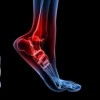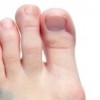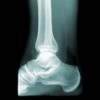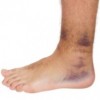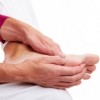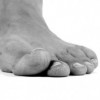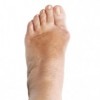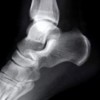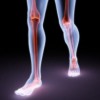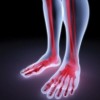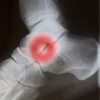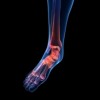Ankle & Foot
Ankle sprains are a common injury, they are normally the result of landing awkwardly after a jump or fall, sport activities like football tackles or even twisting your ankle in high heels. In fact, any activity where the ankle rolls and twists with your body weight behind it can result in an ankle sprain.
An ankle sprain causes a very intense, immediate sharp pain around the ankle with pain that radiates up into the shin, calf and knee and down into the foot. In some cases a tearing or snapping noise is heard during the injury. The sprain will be accompanied by swelling and bruising that will be incredibly tender to touch. Pain levels will be aggravated by any foot movements which can make weight bearing and walking very painful.
It can be hard to distinguish between severe sprains, strains or fractures. Due to the risk of damage to the arterial and nervous supply to the foot, suspected ankle fractures are considered a medical emergency.
Hallux rigidus is a term used to describe a disorder of the metatarsal-phalangeal joint located at the base of the big toe.
The symptoms include decreased movement in the big toe with pain and stiffness more noticeable during or after activities like walking, running and standing. Hallux rigidus is a progressive condition and over time the big toes will become completely stiffened and almost frozen.
Sever's disease is the most common cause of heel pain within young adolescence. Sever's disease is heal pain caused by repetitive strain or trauma to the growth plate of the calcaneus bone (the heel bone) in young athletic individuals between the age of 9-13.
Symptoms include a strong dull ache and stiffness around the heel area particularly intense after activities, during the night and early morning. The pain doesn't always stay concentrated around the heel and may refer up into the calf muscles or down into the foot. The heel will be very tender to touch and tight fitted shoes may become uncomfortable and irritating.
Tarsal tunnel syndrome is the medical term for injury or compression of the posterior tibial nerve as it passes through the tarsal tunnel, a small cavity that lies on the inside of the ankle. It is most commonly seen in people who have hypermobile or weak ankles and suffer from repetitive ankle sprains. Symptoms include an intense sharp pain, tingling and burning around the inside of the ankle and into the sole of the foot with the possible addition of numbness, local swelling and bruising.
A tailor's bunion, also known as a bunionette, is the medical term for a raised lump/bump at the base of the little toe. The early stages of a bunion will have minimal symptoms with only a slight noticeable alteration in the position of your little toe. These symptoms will progress to a greater deformity accompanied by pain and stiffness levels.
Hammertoe is the term to describe a contracture or bending of one or both proximal interphalangeal and distal interphalangeal joints of the toes.
Symptoms begin as a mild bending deformity of the toe. The toe will still be flexible but pain and discomfort will be experienced after wearing tight shoes. Gradually over time corns and calluses will develop as the deformity and rigidness of the toe progress, as will the pain and discomfort levels.
Hallux valgus or its full name of hallux abducto valgus is more commonly known as a bunion. A bunion is often described as a visible bump on the side of the foot at the base of the big toe.
Symptoms will begin as a slight noticeable alteration in the position of your big toe. To start with the toe will slightly lean towards the other toes, progressively the lean will worsen to the point that in some cases the big toe starts to completely overlap the second toe.
Tarsal coalition is a relatively uncommon condition affecting only a small proportion of the population. The reason for this congenital condition is unknown but it is thought to be a birth defect.
In many cases tarsal coalition is a silent condition meaning it doesn't cause and symptoms of pain or discomfort however this is not always the case. The coalition of the tarsals itself does not cause pain but the altered way in which the foot works due to the coalition can create problems.
Pes cavus also known as high arches or cavus foot is a condition in which the arch of the foot is significantly greater than a normal foot arch.
Symptoms include a notably elevated arch when standing. The mid foot will be stiff and inflexible and pain and discomfort will be felt when walking and weight-bearing. Toe deformities and calluses around the heel and ball of the foot often develop due to an increased pressure through these areas.
Flatfoot also known as fallen arches or pes planus is a condition in which the medial arch of the foot collapses. The extent of the collapse causes the sole of the foot to come into partial or complete contact with the floor when standing. There are various types of flatfoot including adult acquired flatfoot, paediatric flatfoot and flexible flatfoot. Symptoms include pain, tenderness and cramping in the foot as well as toe and heel deformities.
Osteoarthritis in the Ankle & Foot
Osteoarthritis is a chronic degenerative disorder that is also referred to as joint degeneration but you will probably have heard most people use the term "joint wear & tear".
Symptoms initially start as mild ankle or foot pain and stiffness. The pain is likely to feel generalized rather than a pin point pain location. Gradually as the joint becomes more and more degenerated the joint pain symptoms will be coupled by intense stiffness leading to severe stiffness and painful joint locking.
This condition article is currently being processed by Clinic HQ. All articles will be processed and uploaded as soon as possible. Thank you for your patience.

